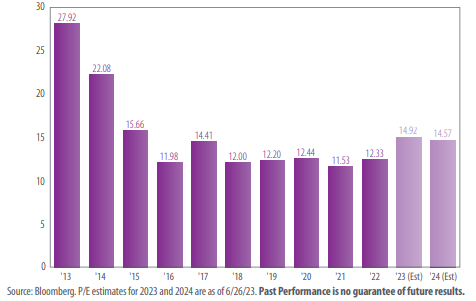
View from the Observation Deck
In last week’s post titled “A Check Up on Health Care”. We shared an update on the valuations and pricing of stocks in the Health Care sector. Today, we take the analysis one layer deeper and discuss the current climate surrounding Biotechnology stocks, as represented by the S&P 500 Index Biotechnology subsector.
Biotechnology stocks may offer a comparative value to the broader S&P 500 and the S&P 500 Health Care Indices.
As today’s chart shows, the estimated year-end 2023 P/E ratio for the S&P 500 Biotechnology Index stood at 14.92 as of 6/26/23, well below the average P/E of 17.53 for the 10-year period ended on the same date (not shown in chart). For comparison, the S&P 500 and S&P 500 Health Care Indices have estimated 2023 year-end P/E ratios of 19.59 and 17.75, and 10-year historical average P/E ratios of 20.37 and 20.56, respectively.
Biotechnology stocks outperformed both the broader S&P 500 Index and the S&P 500 Health Care Index over the 20 and 30-year periods ended 6/26/23.
Over the 20-year period ended 6/26/23, Biotechnology stocks recorded an average annual total return of 10.51%. For comparison, the S&P 500 and the S&P 500 Health Care Indices posted average annual total returns of 9.81% and 9.63%, respectively, over the same time frame. The gap in Biotechnology’s outperformance was even wider over the 30-year period ended on the same date. From 6/25/93 to 6/26/23, the S&P 500 Biotechnology Index posted an average annual total return of 16.33% while the S&P 500 and S&P 500 Health Care Indices registered total returns of 9.95% and 11.91%, respectively.
Biotechnology’s performance advantage appears to have eroded in recent years.
Over the 10-year period ended 6/26/23, the S&P 500 Biotechnology Index posted an average annual total return of 10.69%, compared to 12.55% for the S&P 500 Index and 12.58% for the S&P 500 Health Care Index. The deterioration of the prices of Biotechnology companies has continued in 2023. Year-to-date (YTD) through 6/26/23, the Biotechnology, S&P 500, and Health Care Indices posted total returns of -8.83%, 13.67%, and -2.64%, respectively. From our vantage point, several factors are likely behind this trend. First, rising interest rates could be causing investors to seek safer ways to earn a return on their investment. Second, and perhaps more importantly, is the impact of governmental regulation on the industry. The recent Inflation Reduction Act gave Medicare the ability to force companies into price negotiations or face significant excise taxes, leading to concerns that price fixing could impact the valuation of some Biotech companies who have significant investments in the research and development of those drugs. Additionally, merger and acquisitions (M&A) activity in the subsector has yet to retest its pre-COVID highs. Globally, there were 1,733 M&A deals in the subsectors in 2022, down from 2,475 in 2018.
Takeaway
In recent years, the total returns of the S&P 500 Biotechnology Index have lagged those of the broader S&P 500 and S&P 500 Health Care Indices. The Biotechnology sector has faced significant headwinds in the form of higher interest rates, political intervention with regards to drug pricing, and declining M&A activity. Despite these difficulties, the annual earnings (in dollars) on the S&P 500 Biotechnology Index increased from $100.38 per share in 2013 to $437.87 per share in 2022. With current and 10-year average P/E ratios of 12.84 and 17.53, respectively, Biotechnology’s recent valuations could be attractive to investors looking to take advantage of the long-term prospects of the new and potentially revolutionary drugs that may come from the subsector.



